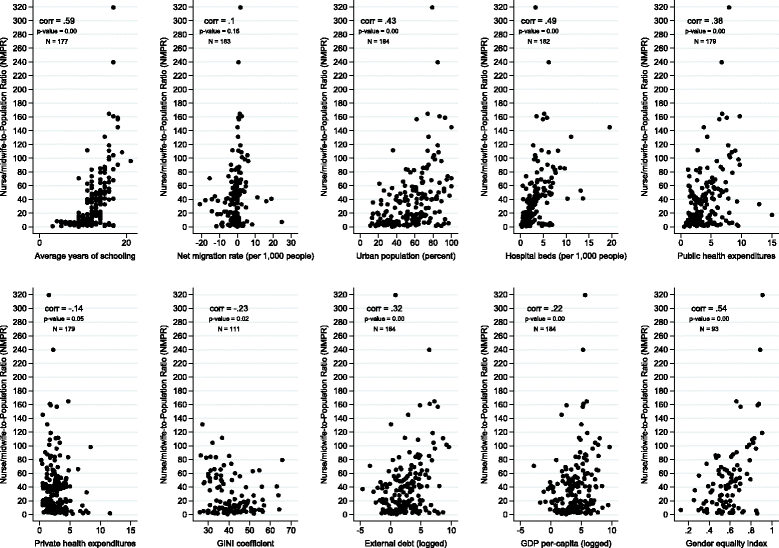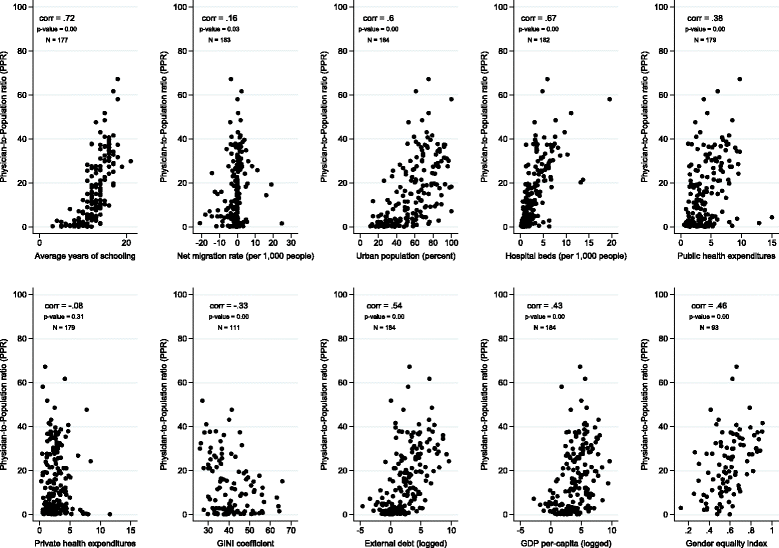Examining the influence of country-level and health system factors on nursing and physician personnel production
- PMID: 27523185
- PMCID: PMC4983794
- DOI: 10.1186/s12960-016-0145-4
Examining the influence of country-level and health system factors on nursing and physician personnel production
Abstract
Background: A key component to achieving good patient outcomes is having the right type and number of healthcare professionals with the right resources. Lack of investment in infrastructure required for producing and retaining adequate numbers of health professionals is one reason, and contextual factors related to socioeconomic development may further explain the trend. Therefore, this study sought to explore the relationships between country-level contextual factors and healthcare human resource production (defined as worker-to-population ratio) across 184 countries.
Methods: This exploratory observational study is grounded in complexity theory as a guiding framework. Variables were selected through a process that attempted to choose macro-level indicators identified by the interdisciplinary literature as known or likely to affect the number of healthcare workers in a country. The combination of these variables attempts to account for the gender- and class-sensitive identities of physicians and nurses. The analysis consisted of 1 year of publicly available data, using the most recently available year for each country where multiple regressions assessed how context may influence health worker production. Missing data were imputed using the ICE technique in STATA and the analyses rerun in R as an additional validity and rigor check.
Results: The models explained 63 % of the nurse/midwife-to-population ratio (pseudo R (2) = 0.627, p = 0.0000) and 73 % of the physician-to-population ratio (pseudo R (2) = 0.729, p = 0.0000). Average years of school in a country's population, emigration rates, beds-per-1000 population, and low-income country statuses were consistently statistically significant predictors of production, with percentage of public and private sector financing of healthcare showing mixed effects.
Conclusions: Our study demonstrates that the strength of political, social, and economic institutions does impact human resources for health production and lays a foundation for studying how macro-level contextual factors influence physician and nurse workforce supply. In particular, the results suggest that public and private investments in the education sector would provide the greatest rate of return to countries. The study offers a foundation from which longitudinal analyses can be conducted and identifies additional data that may help enhance the robustness of the models.
Keywords: Complexity theory; Global health; Human resources for health; Nurse-to-population ratio; Physician-to-population ratio; Policy; Socioeconomic development.
Figures
References
-
- Ausserhofer D, Zander B, Busse R, Schubert M, De Geest S, Rafferty AM, Ball J, Scott A, Kinnunen J, Heinen M, Strømseng Sjetne I, Moreno-Casbas T, Kózka M, Lindqvist R, Diomidous M, Bruyneel L, Sermeus W, Aiken LH, Schwendimann R. Prevalence, patterns and predictors of nursing care left undone in European hospitals: results from the multicountry cross-sectional RN4CAST study. BMJ Qual Saf. 2014;23:126–35. doi: 10.1136/bmjqs-2013-002318. - DOI - PubMed
MeSH terms
LinkOut - more resources
Full Text Sources
Other Literature Sources
Medical



